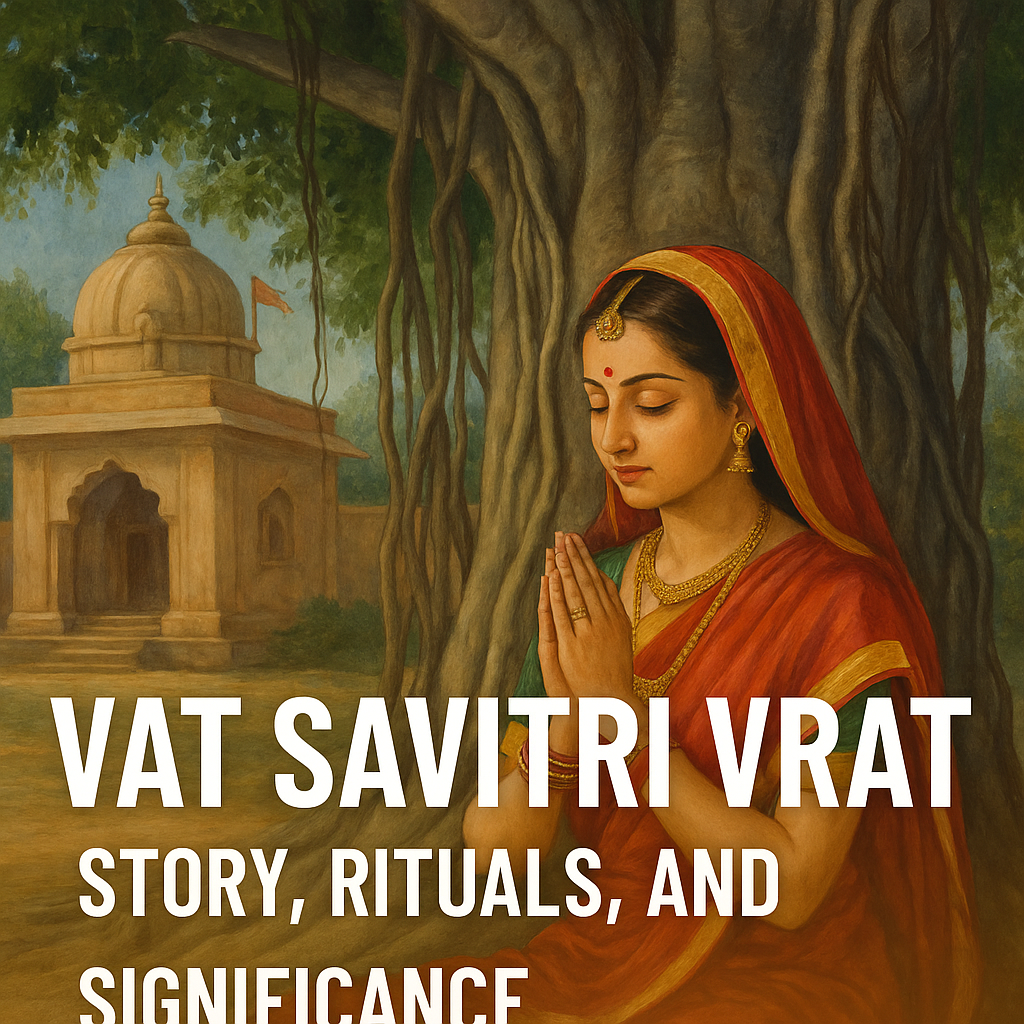
Vat Savitri Vrat: The Epic Tale of Devotion, Dharma & Love
Introduction: A Sacred Celebration of Love, Devotion, and Dharma
Vat Savitri Vrat is one of the most revered Hindu fasts observed by married women in India, especially in the states of Maharashtra, Uttar Pradesh, Bihar, Odisha, and Gujarat. This vrat (fast) celebrates the unshakable devotion of Savitri, who brought her husband Satyavan back from the clutches of death through her tapasya (austerity), intelligence, and unwavering dharma.
The vrat is primarily observed under a Vat (banyan) tree, which symbolizes longevity, endurance, and prosperity — ideals deeply embedded in a harmonious marital life.
Textual Sources: Where is the Story of Savitri and Satyavan Found?
The story of Savitri and Satyavan is one of the most beautiful and inspiring episodes of the Mahabharata, specifically found in the Vana Parva (Book of the Forest). It is recounted by Rishi Markandeya to Yudhishthira, when he grieves for Draupadi’s hardships during exile.
Apart from the Mahabharata, references to the Savitri-Satyavan story can be found in: Skanda Purana, Padma Purana and localized folklore and regional Kathas retold in vernacular traditions.
The Mahabharata version remains the most authoritative, detailed, and symbolically rich.
Full Story of Savitri and Satyavan: The Tale of Love and Death
Savitri, the daughter of King Ashvapati of Madra, was born as a boon from the goddess Savitri herself. As she grew up, she was unmatched in beauty, wisdom, and virtue. When she reached marriageable age, she chose Satyavan, the exiled prince of Shalva who lived in the forest with his blind father Dyumatsena.
Narada Muni warned that Satyavan had only one year to live, but Savitri, resolute in her decision, insisted on marrying him. After one year, on the destined day of Satyavan’s death, she followed him to the forest. When Yama, the god of death, came to take Satyavan’s soul, Savitri followed him, engaging in profound philosophical dialogue.
Impressed by her truthfulness, devotion, and wisdom, Yama granted her five boons, carefully excluding Satyavan’s life. In her fifth boon, she asked for a hundred sons by Satyavan — cleverly implying he must be returned to life. Yama, bound by his own word, restored Satyavan to life.
Historic and Cultural Significance: Is the Story Historically True?
While the story of Savitri is mythological in structure, it is not devoid of historic and symbolic truths. Scholars view it as an allegorical tale embedded in Vedic values of dharma, feminine power (shakti), satya (truth), and karma. The character of Savitri represents ideal womanhood in ancient Hindu society — educated, independent in decision-making, and spiritually evolved.
Regional Variations in Observance
The Vat Savitri Vrat is observed differently across India, based on regional calendars and local traditions:
In North India (UP, Bihar), the fast is observed on the Amavasya of Jyeshtha month.
In Maharashtra, Gujarat, and South India, it is celebrated on the Jyeshtha Purnima and often referred to as Vat Purnima.
Some communities combine it with the worship of Shani Dev or perform Satyanarayan Katha alongside.
While panchopchar puja (five-fold worship) is common, in Odisha, the ritual may involve elaborate tribal customs and symbolic storytelling.
Lessons from the Story: What Modern Women Can Learn from Savitri
Inner Strength Is True Power:
Savitri did not rely on physical strength but on willpower, faith, and intellect.
Wisdom Wins Over Fate:
Her logical dialogue with Yama shows that righteous persistence can even change destiny.
Equality in Dharma:
Savitri is shown as equal or superior in resolve to male sages, emphasizing gender parity in spiritual strength.
Love Rooted in Dharma:
Her love was not emotional dependence, but a spiritual partnership.
Grace Under Pressure:
She endured sorrow silently, made no demands, and still achieved the impossible.
Conclusion: The Everlasting Relevance of Savitri
The Vat Savitri Vrat is not just a ritual — it’s a celebration of the divine feminine, of a woman’s capacity to uphold dharma, protect her family, and shape her own destiny. In Savitri, we find a timeless heroine, one who remains a beacon of faith and devotion.
As modern Hindu women adapt the rituals with changing times, the spirit of Savitri continues to inspire inner strength, moral courage, and spiritual wisdom.
FAQs on Vat Savitri Vrat
1. What is Vat Savitri Vrat?
It’s a Hindu fast where married women pray for their husband’s long life by worshipping the banyan (Vat) tree, inspired by the story of Savitri and Satyavan.
2. Who were Savitri and Satyavan?
Savitri was a devoted wife who brought her husband back from death by her wisdom and dedication. The story comes from the Mahabharata.
3. When is it celebrated?
North India: Jyeshtha Amavasya (new moon)
Maharashtra & South India: Jyeshtha Purnima (full moon), called Vat Purnima
4. What items are needed for the puja?
Chana, banyan tree, bamboo basket and fan, fruits, sweets, sindoor, bangles, diya, and sacred red thread (mauli).
5. Why is the thread tied around the banyan tree?
It symbolizes marital devotion, longevity, and 12 months of prayers for the husband’s well-being.
6. Can unmarried girls do this vrat?
Traditionally for married women, but unmarried girls may do it for blessings for a good life partner.
7. Is the story real?
It’s a mythological story from the Mahabharata, full of moral and spiritual lessons, not historical fact.
8. What does the banyan tree represent?
It stands for long life, stability, and ecological balance — making it sacred and symbolic.
9. What can we learn from Savitri?
Courage, faith, intelligence, and strength of a woman’s love and dharma can even overcome fate.
10. Where can I learn more?
👉 Visit: www.dharmayug.com
📲 Follow: @dharmayugofficial on Instagram
